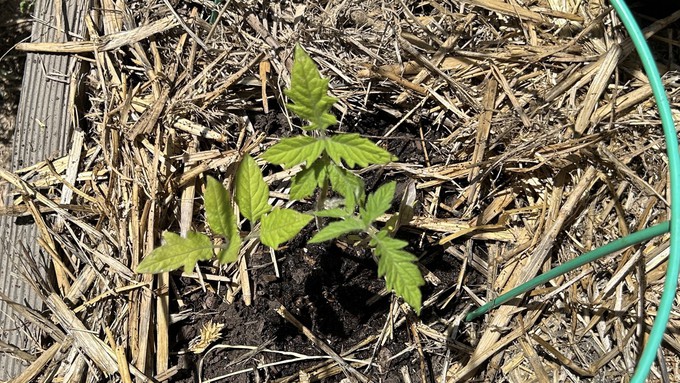
Get ready for warm, sunny and breezy days ahead

Keep new transplants irrigated, and surround them with mulch (straw in this case) to slow evaporation of moisture from the soil. This one will green up more as it settles into its new spot. Kathy Morrison
Pretty warm but not quite hot; that’s the Sacramento forecast for the week ahead. Tempering afternoon highs (and keeping them below 90 degrees) will be gusty afternoon winds. So, hang onto your sunhat – and tie down those fast-growing vines.
According to the National Weather Service, Sacramento can expect afternoon highs in the 80s through at least Memorial Day weekend, topping out at 89 degrees on Tuesday. That’s well above average – 81 degrees – for mid-May in Sacramento.
Overnight lows will settle comfortably into the high 50s – warm enough to speed up plant development.
Afternoon winds gusting up to 20 mph will cool off most days. But those breezes will also speed evaporation; keep seedlings moist. They’re dependent on irrigation; no rain is in Sacramento’s forecast.
With those breezes in mind, give some support to growing tomatoes, peppers, eggplants and other transplants with stakes, trellises or cages.
Take care of chores early in the day – then enjoy the afternoon. It’s time to smell the roses.
* Plant, plant, plant! It’s prime planting season in the Sacramento area. If you haven’t already, it’s time to set out those tomato transplants along with peppers and eggplants. Pinch off any flowers on new transplants to make them concentrate on establishing roots instead of setting premature fruit.
* Direct-seed melons, cucumbers, summer squash, corn, radishes, pumpkins and annual herbs such as basil.
* Harvest cabbage, lettuce, peas and green onions.
* In the flower garden, direct-seed sunflowers, cosmos, salvia, zinnias, marigolds, celosia and asters.
* Plant dahlia tubers. Other perennials to set out include verbena, coreopsis, coneflower and astilbe.
* Transplant petunias, marigolds and perennial flowers such as astilbe, columbine, coneflowers, coreopsis, dahlias, rudbeckia and verbena.
* Keep an eye out for slugs, snails, earwigs and aphids that want to dine on tender new growth.
* Give summer bloomers a dose of a balanced fertilizer.
* For continued bloom, cut off spent flowers on roses as well as other flowering plants.
* Don’t forget to water. Seedlings need moisture. Deep watering will help build strong roots and healthy plants.
* Add mulch to the garden to help keep that precious water from evaporating. Mulch also cuts down on weeds. But don’t let it mound around the stems or trunks of trees or shrubs. Leave about a 6-inch to 1-foot circle to avoid crown rot or other problems.
Comments
0 comments have been posted.Sacramento Digs Gardening to your inbox.
Sites We Like
Garden Checklist for week of July 21
Your garden needs you!
* Keep your vegetable garden watered, mulched and weeded. Water before 8 a.m. to reduce the chance of fungal infection and to conserve moisture.
* Feed vegetable plants bone meal, rock phosphate or other fertilizers high in phosphate to stimulate more blooms and fruiting. (But wait until daily high temperatures drop out of the 100s.)
* Don’t let tomatoes wilt or dry out completely. Give tomatoes a deep watering two to three times a week.
* Harvest vegetables promptly to encourage plants to produce more. Squash especially tends to grow rapidly in hot weather. Keep an eye on zucchini.
* Pinch back chrysanthemums for bushy plants and more flowers in September.
* Remove spent flowers from roses, daylilies and other bloomers as they finish flowering.
* Pinch off blooms from basil so the plant will grow more leaves.
* Cut back lavender after flowering to promote a second bloom.
* It's not too late to add a splash of color. Plant petunias, snapdragons, zinnias and marigolds.
* From seed, plant corn, pumpkins, radishes, winter squash and sunflowers.